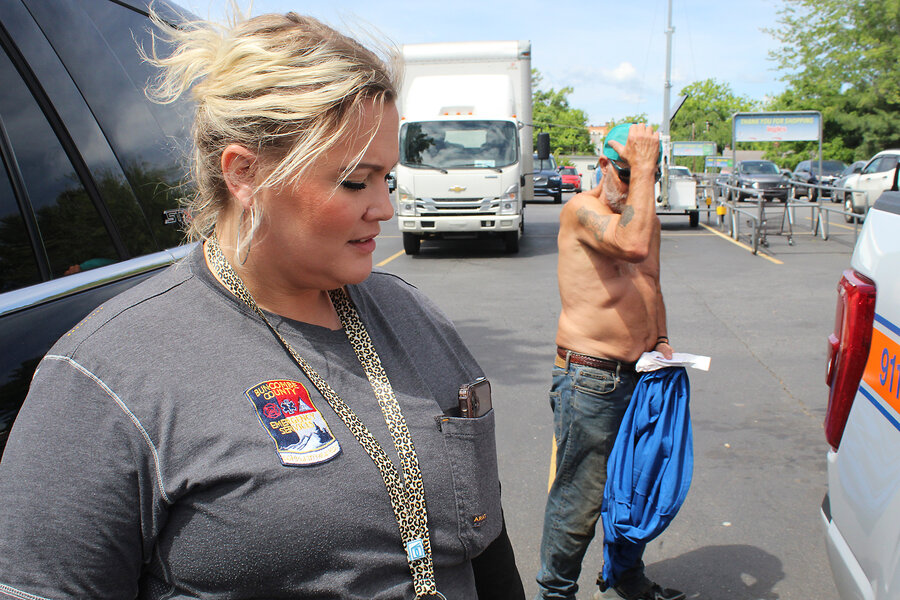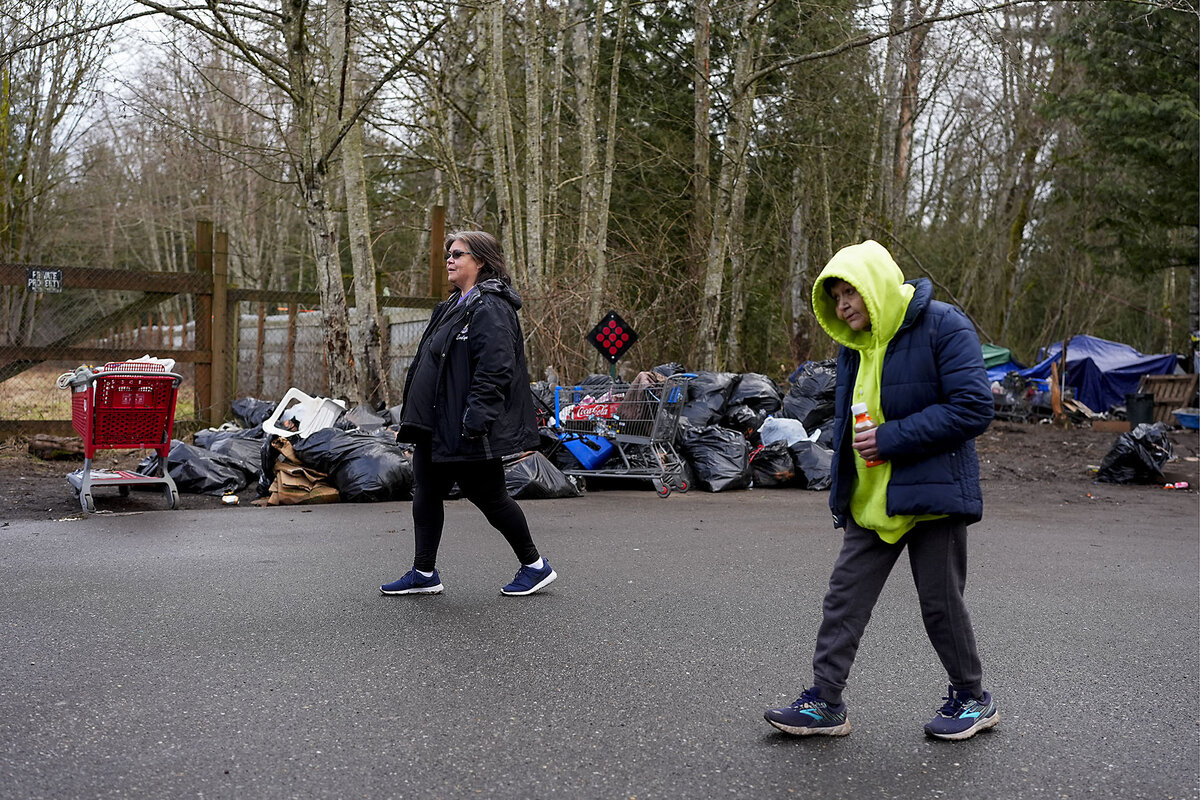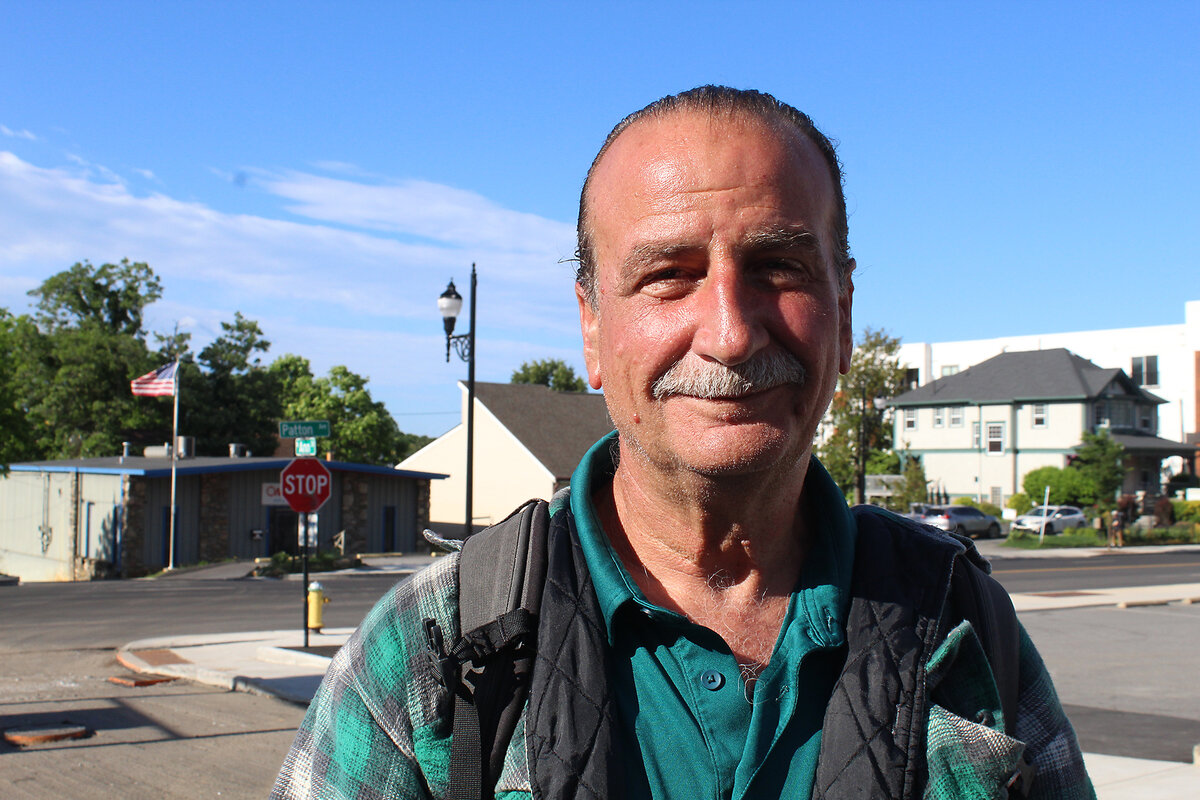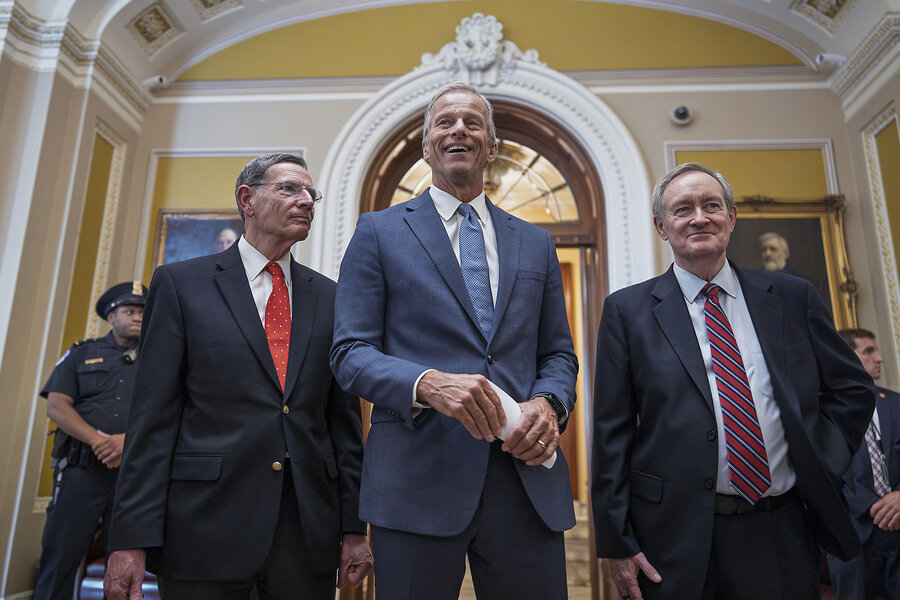Now Reading: How Medicaid cuts may endanger US progress battling opioid addiction
-
01
How Medicaid cuts may endanger US progress battling opioid addiction
How Medicaid cuts may endanger US progress battling opioid addiction

As she heads out onto the rolling streets of Asheville, North Carolina, Brandi Hayes is moved by a memory of a father she barely knew.
Part of the area’s five-year-old Post Overdose Response Team (PORT), she races to emergency calls in a county-owned vehicle. With each rescue attempt, she is reminded of her own father’s death following a heroin overdose at age 27.
Ms. Hayes’ work, like PORT’s efforts, doesn’t stop at the 911 calls. The four-unit team follows up within 72 hours to provide support, education, counseling, and linkage to care. Given that Medicaid pays for most opioid abuse treatment here, the government’s low-income insurance program is intricately linked to PORT’s mission.
Why We Wrote This
Americans want to help combat drug addiction, within limits. Cuts to Medicaid, which supports many overdose programs, could have community repercussions nationwide.
“Medicaid is a huge part of what we do,” she says.
Now, as Republicans move to limit Medicaid spending – hoping to rein in government and offset proposed tax cuts – opioid treatment efforts like those here in Asheville face an uncertain future. It’s part of a broader controversy around the One Big Beautiful Bill Act, now nearing final approval in Congress. Even among Republicans, the Medicaid cuts are causing tension amid forecasts that millions of Americans could become uninsured.
Eligibility changes to Medicaid are coming at a “tenuous moment” for the opioid crisis, according to KFF, a nonprofit that provides non-partisan reporting on national health policy. Nearly two-thirds of those with opioid addiction who are seeking treatment are on Medicaid, it says.
Some 71 million Americans are currently enrolled in Medicaid, according to recent government data. The proposed changes could result in nearly 12 million more people being uninsured over the next decade. Spending cuts of up to $1 trillion, critics say, would be used to extend tax benefits to corporations and households earning over $200,000 per year.
“You might wonder, if it is generally poor, white men who are dying of drug overdoses, why would this administration, which is built on the backs of lower education white male voters, abandon something that’s working?” says David Herzberg, co-author of “Whiteout: How Racial Capitalism Changed the Color of Opioids in America.”

Three women and their baby daughters – Sandi Fox and Talia, (Left) Nathalie Demirdjian-Rivest and Helena (Middle), and Allison Walker and Savannah (Right) – gather with other Moms Rising activists to oppose Medicaid cuts on Capitol Hill in Washington, June 25, 2025.
The opioid epidemic contributed to more than 100,000 overdose deaths in the U.S. in 2022, according to the Centers for Disease Control and Prevention, with some 7 million Americans estimated to be dependent on some form of opioid, whether prescription, fentanyl, or heroin.
But last year, those overdose deaths dropped 27% nationwide and by a similar amount here in North Carolina, an encouraging sign to frontline workers like Ms. Hayes.
Aside from PORT’s response and wrap-around services, the decline, she says, is the result of myriad factors, including community saturation of the overdose-fighting drug Narcan, expansion of MAT, or medication assisted treatment, the worsening quality of heavy street drugs thanks to interdiction efforts, and hesitancy by many to get involved in opioids given to the spike in overdose deaths that affected their communities.
The Trump administration has focused on an array of strategies, including securing borders where the drugs have been trafficked, medical interventions, and disrupting the global pipeline of fentanyl, the opioid at the root of the overdose spike.
“We will take action to continue to love and cherish the Medicare and Medicaid programs to ensure they are preserved for those who need them most,’’ says a June 6 executive order signed by President Trump that refers to seniors as the primary Medicaid recipients it is focused on. (While seniors are covered by Medicare, many also turn to Medicaid due to low incomes.)
For working-age adults, Senate and House versions of the bill include a requirement to work, volunteer, or study 80 hours a month to qualify for enrollment, unless they have an exception.
The bill’s rollback of eligibility exempts those with addiction disorders seeking treatment. But there are broad concerns about other eligibility and reporting requirements for those with drug problems; whether federal cuts will lead states to cut payments to abuse treatment providers; and the impact of the cuts on rural hospitals, which have been the primary concern for holdout Republicans like Sen. Thom Tillis of North Carolina.
People in conservative rural areas are often more likely to qualify for Medicaid, but getting help for drug addictions can often be difficult since some conservative states limit the kind of prescriptions that can be used for treatment, as well as what services are available.
“Medicaid is a big, if not the biggest, player, and a huge factor in how people with opioid abuse disorder get care,” says Joshua Lynch, an associate professor of emergency and addiction medicine at the University at Buffalo Jacobs School of Medicine and Biomedical Sciences in New York. “Reducing access to care following a year where deaths have been reduced is absolutely not the right answer. The opioid epidemic continues to evolve, and we need to evolve our response.”
Much the way crack cocaine impacted predominantly Black, urban neighborhoods in the 1990s, opioid dependence and overdoses bulldozed through rural America, mainly affecting young adult and middle-aged white men.
But in the past 15 years, overdose deaths among U.S. minorities, including from the use of opioids, have accelerated the fastest, with the mortality rate among Black Americans rising by 249% between 1999 and 2022.

Rachel Cooper, who says she was introduced to fentanyl by her kids, walks with Evelyn Jefferson, left, a Lummi Nation crisis outreach supervisor, at the edge of an encampment for homeless people near a Walmart store in Bellingham, Washington, Feb. 8, 2024.
Although drug use has typically been considered a problem for poor, urban communities, Americans more generally have grown increasingly sympathetic toward opioid users seeking care. Three in 10 say they or a family member has experienced opioid addiction.
And it is not just an issue for Democrats. More than half of Republicans (55%) oppose major cuts to the current Medicaid program. Sen. Josh Hawley, the Republican from Missouri, has called the proposed Medicaid rules “morally wrong and politically suicidal,’’ saying that the cuts would alienate working-class voters.
But there is a limit to that concern.
Rep. Nicole Malliotakis of New York, an early Republican critic of the Medicaid reductions, told CNN recently that she changed her mind and was now supporting the cuts because they target “people in the country illegally” and “people who refuse” to meet work requirements.
Attitudes about who should receive help can shift depending on historical patterns and whether “favored groups” are the ones suffering, says Professor Herzberg, a historian also at the University of Buffalo.
Places like Asheville, a leafy, vibrant city that some locals see as an “oasis” for drug use, are among the testing grounds.
Starting around 2010 through the COVID-19 pandemic, Asheville and the surrounding Buncombe County saw a surge in fentanyl-related overdose deaths, with about half of them being those also experiencing homelessness. The other half came from all socioeconomic backgrounds. According to the North Carolina Coroner’s Office, the victims were restaurant workers, a dance instructor, a jeweler, and a Border Patrol agent.
That toll fueled a local response, which tapped into a culture of recovery in Asheville. Government institutions adopted harm reduction programs over punitive ones. The sheriff was elected in part on his plan to offer medication assisted treatment – which can cut overdose deaths by half – to inmates. Underwriting many of these costs was, again, Medicaid.

Patrik Jonsson/The Christian Science Monitor
Yon Goldblatt, a recovering methamphetamine addict, talks about how Medicaid, the low-income government insurance program, was part of his journey to sobriety, in Asheville, North Carolina, on May 29, 2025.
Yon Goldblatt, a recovering methamphetamine addict who is homeless and living in Asheville, says Medicaid got him on the road to recovery.
But he understands how many Americans grow impatient with helping people who don’t seem willing – or able – to help themselves. “It’s like saving someone from drowning and then watching them jump right back in the water,” says the former massage therapist.
Professor Herzberg offers a different read. To him, it’s like pulling a drowning person to the surface and then releasing them only after they’ve had the chance to take a breath.
Medicaid cuts, he says, could jeopardize ready resources for addiction-affected places like Asheville to help them develop – and provide – harm reduction programs, fentanyl test strips, and other drug deterrents.
“We have this continuum in the U.S. where harm reduction is really respected and in other places it’s not,” says Professor Lynch, a former emergency medical technician. “You can get people on a recovery pathway. Or you can say, ‘Too bad. You get nothing.’”
As Ms. Hayes and her team gather in a grocery store parking lot, she hails a shirtless man and waves him over. His name is Shawn Vandernick, and he was her father’s best friend. Mr. Vandernick says that he has been a long-time meth addict. But he credits Ms. Hayes’ PORT team for helping him seek Medicaid-funded treatment.
“There’s no doubt,’’ he says with a bright grin. “Their efforts are paying off.”























